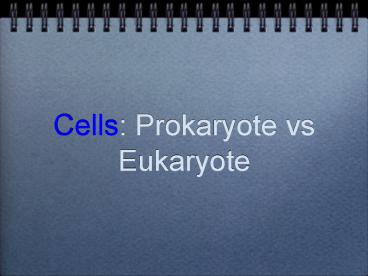Cells: Prokaryote vs Eukaryote PowerPoint PPT Presentation
1 / 39
Title: Cells: Prokaryote vs Eukaryote
1
Cells Prokaryote vs Eukaryote
2
Cells have evolved two different architectures
- Prokaryote style
- Eukaryote style
3
Prokaryote cells are smaller and simpler
- Commonly known as bacteria
- 10-100 microns in size
- Single-celled(unicellular) or
- Filamentous (strings of single cells)
4
These are prokaryote E. coli bacteria on the
head of a steel pin.
5
Prokaryote cells are simply built (example E.
coli)
- capsule slimy outer coating
- cell wall tougher middle layer
- cell membrane delicate inner skin
6
Prokaryote cells are simply built (example E.
coli)
- cytoplasm inner liquid filling
- DNA in one big loop
- pilli for sticking to things
- flagella for swimming
- ribosomes for building proteins
7
Prokaryote lifestyle
- unicellular all alone
- colony forms a film
- filamentous forms a chain of cells
8
Prokaryote Feeding
- Photosynthetic energy from sunlight
- Disease-causing feed on living things
- Decomposers feed on dead things
9
Eukaryotes are bigger and more complicated
- Have organelles
- Have chromosomes
- can be multicellular
- include animal and plant cells
10
Organelles are membrane-bound cell parts
- Mini organs that have unique structures and
functions - Located in cytoplasm
11
Cell Structures
- Cell membrane
- delicate lipid and protein skin around cytoplasm
- found in all cells
12
- Nucleus
- a membrane-bound sac evolved to store the cells
chromosomes(DNA) - has pores holes
13
- Nucleolus
- inside nucleus
- location of ribosome factory
- made or RNA
14
- mitochondrion
- makes the cells energy
- the more energy the cell needs, the more
mitochondria it has
15
- Ribosomes
- build proteins from amino acids in cytoplasm
- may be free-floating, or
- may be attached to ER
- made of RNA
16
- Endoplasmic reticulum
- may be smooth builds lipids and carbohydrates
- may be rough stores proteins made by attached
ribosomes
17
- Golgi Complex
- takes in sacs of raw material from ER
- sends out sacs containing finished cell products
18
- Lysosomes
- sacs filled with digestive enzymes
- digest worn out cell parts
- digest food absorbed by cell
19
- Centrioles
- pair of bundled tubes
- organize cell division
20
Cytoskeleton
- made of microtubules
- found throughout cytoplasm
- gives shape to cell moves organelles around
inside.
21
Structures found in plant cells
- Cell wall
- very strong
- made of cellulose
- protects cell from rupturing
- glued to other cells next door
22
- Vacuole
- huge water-filled sac
- keeps cell pressurized
- stores starch
23
- Chloroplasts
- filled with chlorophyll
- turn solar energy into food energy
24
How are plant and animal cells different?
25
(No Transcript)
26
Eukaryote cells can be multicellular
- The whole cell can be specialized for one job
- cells can work together as tissues
- Tissues can work together as organs
27
Advantages of each kind of cell architecture
28
Examples of specialized euk. cells
- liver cell specialized to detoxify blood and
store glucose as glycogen.
29
- sperm cell specialized to deliver DNA to egg cell
30
- Mesophyll cell
- specialized to capture as much light as possible
- inside a leaf
31
How do animal cells move?
- Some can crawl with pseudopods
- Some can swim with a flagellum
- Some can swim very fast with cilia
32
Pseudopods
- means fake feet
- extensions of cell membrane
- example ameoba
33
Flagellum/flagella
- large whiplike tail
- pushes or pulls cell through water
- can be single, or a pair
34
Cilia
- fine, hairlike extensions
- attached to cell membrane
- beat in unison
35
How did organelles evolve?
- many scientists theorize that eukaryotes evolved
from prokaryote ancestors. - in 1981, Lynn Margulis popularized the
endosymbiont theory.
36
Endosymbiont theory
- a prokaryote ancestor eats a smaller prokaryote
- the smaller prokaryote evolves a way to avoid
being digested, and lives inside its new host
cell kind of like a pet.
37
Endo insideSymbiont friend
38
- the small prokaryotes that can do photosynthesis
evolve into chloroplasts, and pay their host
with glucose. - The smaller prokaryotes that can do aerobic
respiration evolve into mitochondria, and convert
the glucose into energy the cell can use. - Both the host and the symbiont benefit from the
relationship
39
- Chlorella are tiny green cells that live inside
some amoeba... endosymbiosis may still be
evolving today!

